Making Walls Talk
Posted on July 5, 2023The perfection of art is to conceal art. These words written by the Roman philosopher Quintilian, would resonate deeply with many lighting designers and content creators today, as they explore new ways to transform the stage without being conspicuous to fans.
Much of this “sleight of hand” centers around the video wall. No longer used simply to display breakout patterns and straightforward IMAG images of performers, these walls have become agents of transformation capable of changing the apparent size, shape and texture of the stage, while moving the artist on it off the set and into an entirely different virtual environment.
Many of the techniques used to engender these changes are not new. Generative video spill and transparent (blow-through) walls, for example, have been around for some time. But with the arrival of new software tools, some very early examples of AI, and the expanding imaginations of designers, they have become powerful like never before. As a result, the video-lighting war, which later mellowed into a “partnership,” has now blossomed into a full-fledged creative marriage.
We spoke to a group of designers who have been actively involved in pursuing the exciting, promising, and yes, sometime frightening, world of next generation video wall concepts and asked them to share their thoughts. Collectively, they have been employing their designs to take audiences to new places, all without anyone fully realizing what was going on. It’s an artistic achievement that Quintilian himself would have applauded.
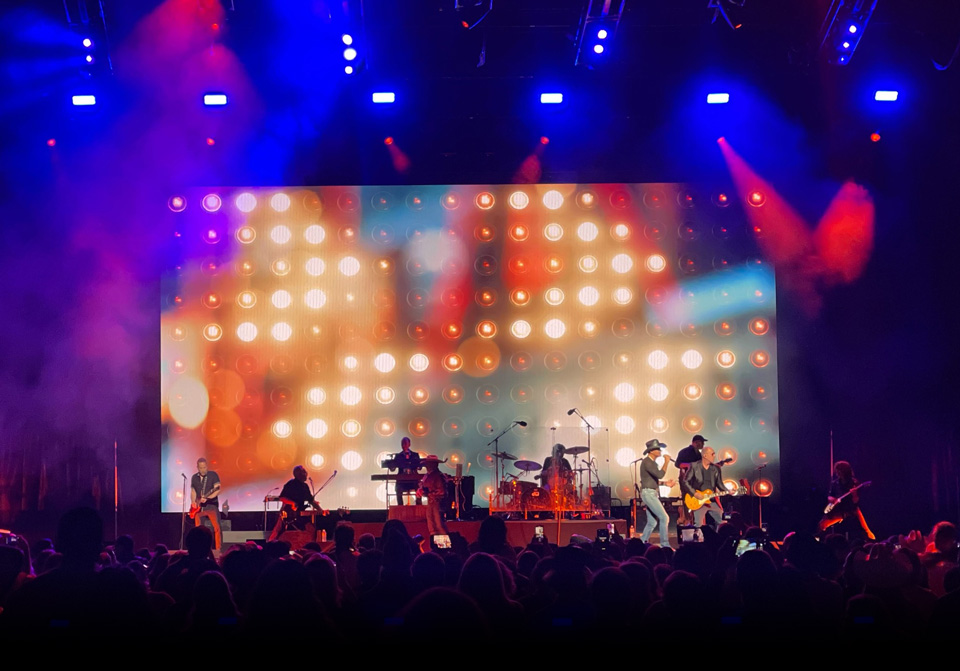
Patrick Dierson, The Activity, Las Vegas
AI: Powerful, Fascinating and Terrifying All At Once
“I wouldn’t say that AI has changed the way I view video as part of a design, but it definitely changes both the process and the economics in which that workflow is produced. If I owned and operated a content creation company that was not learning everything it possibly could about AI visuals creation, I’d be extremely concerned right now. It changes the game. For instance, Bob Bonniol of Mode Studios and I recently did a show together where we were creating the visuals during the rehearsal process in almost real-time. This is unprecedented technology that is powerful, fascinating, and terrifying all at once. Content companies need to learn how to weaponize this technology before it gets actually weaponized, because we’re clearly on at the dawn of the robot takeover. So, we might as well enjoy these exciting times while we still have them.”
The ”New” Blow-Through
“Transparent video walls are nothing new, but continue to be utilized in unique ways. I’d like to think that creatives have only scratched the surface of transparent video display usage. I’m particularly excited to see the evolution of completely transparent glass LED displays as we move into the near future.”
A Similar Path for Video Spill
“Video spilling into the world around it is also both nothing new and the tip of the iceberg in terms of what we’ve done with this up to this point. Pixel mapping LED source lights beyond the extents of video displays is almost considered easy and passé at this point, but bringing that visual information from the screens into the lighting rig just yields incredible results. The ability for a creative team to be able to understand what’s not actually there and allow the audience member’s minds to fill in that missing visual data is always an amazing trick that makes for some of the most creative shows.”
The Integration of IMAG
“The artistic treatment of IMAG being integrated into productions is becoming increasingly popular. Technologies such as Notch have certainly forwarded not just the adoption of the concept but have blown the doors off creative’s ability to come up with their own unique effects and content treatments. Effects that would necessitate my utilizing specialized cameras, IR lighting technology, and custom software are now produced with a plug-in and some relatively simple coding. That’s incredibly powerful and its adoption has become increasingly more common.”
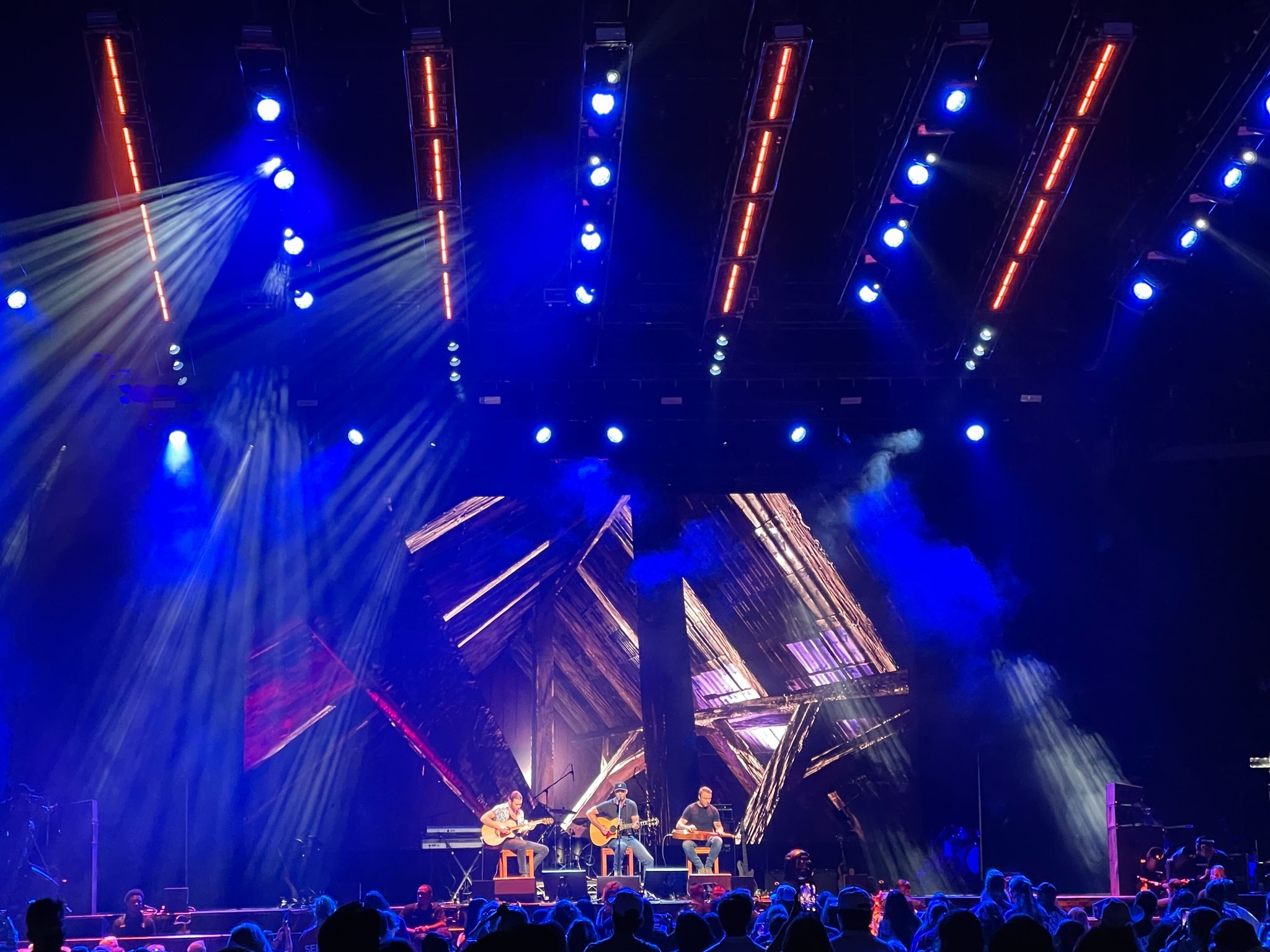
Video and Lighting
“By nature, LED video elements have become increasingly brighter over the decades. For me, this has fortified the need for the video and lighting to be both integrated and coordinated in a way that allows each to visually “speak”. Beams of light can easily become overpowered by the intensity of video walls and thus, as a designer, it becomes imperative to give one or the other a rest in order to develop the shifts from look to look within a show. I see this most egregiously in the genre of festivals. You will so often see these massive video displays on festivals where you basically want to use them for visual information in broad daylight but when night falls, they become overwhelming, and the lighting simply can’t compete at the same time. Most of the best shows that I see are where the LD and VJ are giving each other chances to create their art and letting the audience truly take it in. For me, those are usually the most stunning moments of a show.
Do you see video eventually being displayed on surfaces other than walls?
“The concept of video on surfaces other than walls is also nothing new but I do see it being adopted more and more. For instance, my team helped unveil McLaren’s P1 hyper-car many years ago and it was the first time that a fully immersive, 360 degree projection map was done on a vehicle. At the time, it was an enormous undertaking. Much of the software technology that was developed to produce that effect ultimately became what many take for granted as “easy” in advanced media servers today. It was just the start of how we will see our industry move in amazing directions for decades to come.”
Matthieu Larivee, Lüz Studio, Montreal
The Role of AI in Video Design:
“AI is changing a lot of things but it’s only the tip of the iceberg. For my team, art directors are using it to generate concept boards. Before we needed to get multiple images from the web and add so much description to make sure that whoever was reading our document, was focusing on the right aspect of the image. For instance, you wanted to talk about a shape, you find something a reference image but we had to quote, ignore the aesthetic, just take a look at the shape. Then, you needed to have other aesthetic images to explain your thoughts. Some people can’t envision a concept by seeing plans or references images. Therefore, the AI generated images are great because they combine everything within a single image. We are also using the AI with live cameras to detect human movement. So we are using the technology to detect silhouettes and use the data to create graphic design for the IMAG. That technique required trackers and Kinect motion sensing devices a few years ago. Therefore, it was a much complex rig, which is not always possible to have live.”
On Transparent (Blow-Through) Video Walls:
“I think that the blow through screens are now so well designed that its one of the most perfect products for most of the live shows. The quality of the 8mm – the most common pixel pitch for blow-through– is now great, and it’s sustainable for touring, being very light for rigging. So, it’s one of the great products to create large walls. Of course, when doing other applications, such as TV or a smallest venue, a greater pixel pitch is needed.”
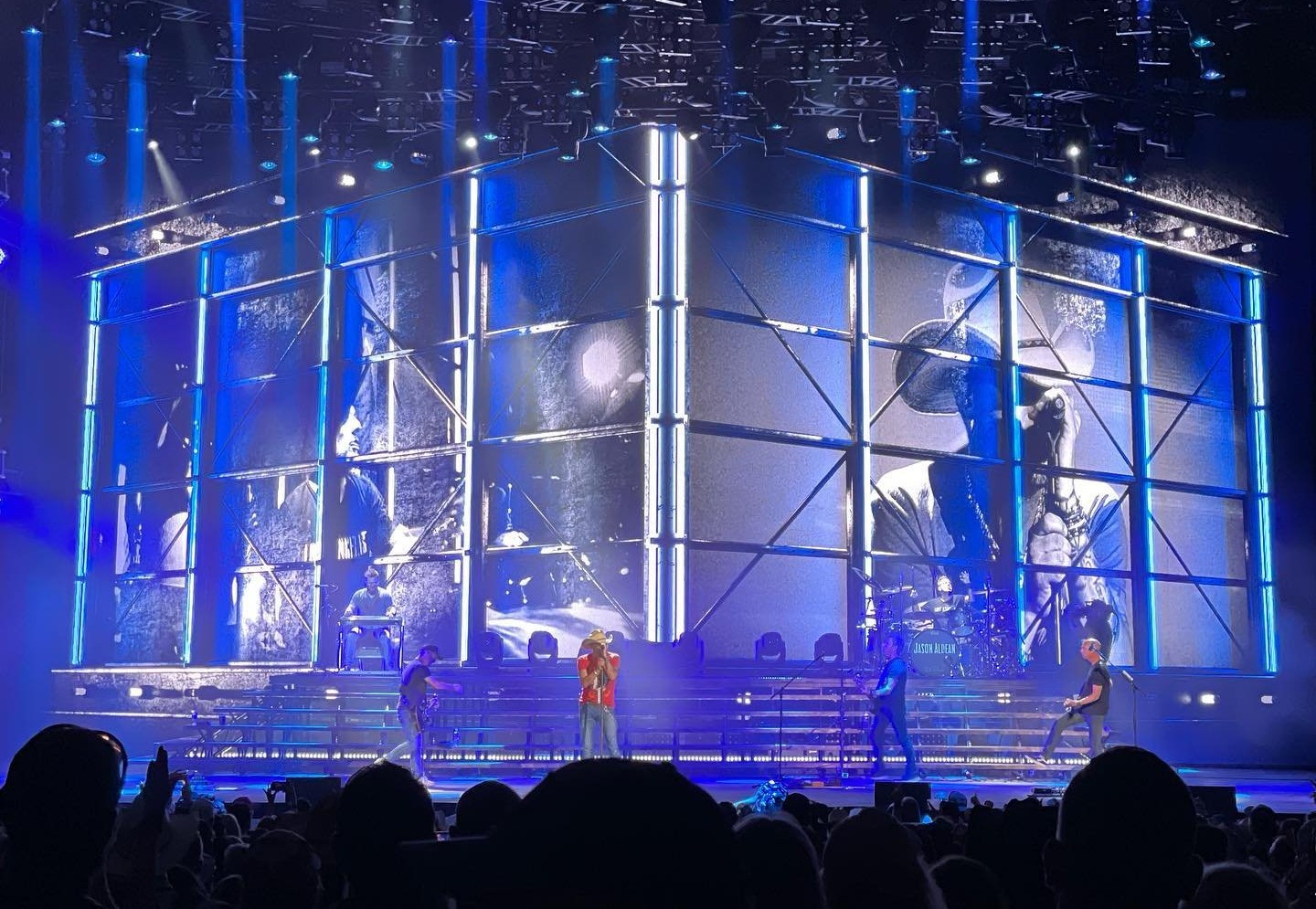
Photo: JP and Sharyn Angers
Integrating IMAG Into Design:
“For some large canvases like Coachella that have the great side walls, IMAGs are designed to fit with the aesthetic of the stage so there’s no need to have IMAGs upstage. But for me, doing arenas and amphitheater, I like to avoid side screens and I don’t like to have live camera behind the artist all the time. I like to get some graphics or lighting that transform the stage into the artist’s art direction. This is where merging both IMAG and graphics are great and especially with our craft of creating set extensions, we’re always making sure there’s a place for an IMAG frame within our designs.”
Impact Of Video On Lighting:
“With all the new crazy lighting fixtures with so many parameters, there’s a lot of possibilities and it requires so much programming time. Using a server to program creative new stuff makes it so much easier. Things have changed!”
Future Directions: “I think that with all the products available now, we’re good for a while. You can use lighting fixtures, LED batten, LED tape, single pixels, projectors and even some programmable propellors. The products will probably refine and get smaller and lighter but the wall will remain there because it needs to be transported and installed, so it needs to be solid.”
Bob Bonniol, MODE Studio, Seattle
The Impact of AI On Design:
“I am not sure it’s changed its role in design, as much as it may be changing the process. It’s an extremely nimble tool for concept development, and also for quickly iterating content for use in production. It’s especially potent when it’s mingled with other parts of the tech, like Unreal Engine or Notch.”

Using Transparent (Blow-Through) Video Walls:
“I am a sucker for creating depth in design, and for promoting an ability to confuse the audience. Using content, and also lighting layers behind a blow through screen to really give an illusion of extra space. I like using that to leave an audience questioning what is real here ?”
Generative Video Spill (When extends past the wall on to the Stage):
“If you are talking about generative video in the context of using platforms like Notch or gaming engines, then that is now hugely significant in my work. I have been blessed to work with some particular artists, Pablo Molina being one, who brought me to this interactive intersection back in 2015 – using tools that made content in the moment and based on performer or audience input.”
IMAG Video In Design:
“This is definitely happening more often, I like to call this ‘ArtMag,’ and I see a lot of the best designers integrating content, lighting, and camera work to create hugely cinematic moments.:
The Roles Of Lighting & Video:
“I’ve always been deliberately hazy about what is light and what is video. I have often referred to projection as complicated gobo work, and conversely I have treated big arrays of PAR cans as pixels. There’s a tighter and tighter knit control mechanism now, and it allows designers to think of video and lighting through a unified lens and to work very tightly.”
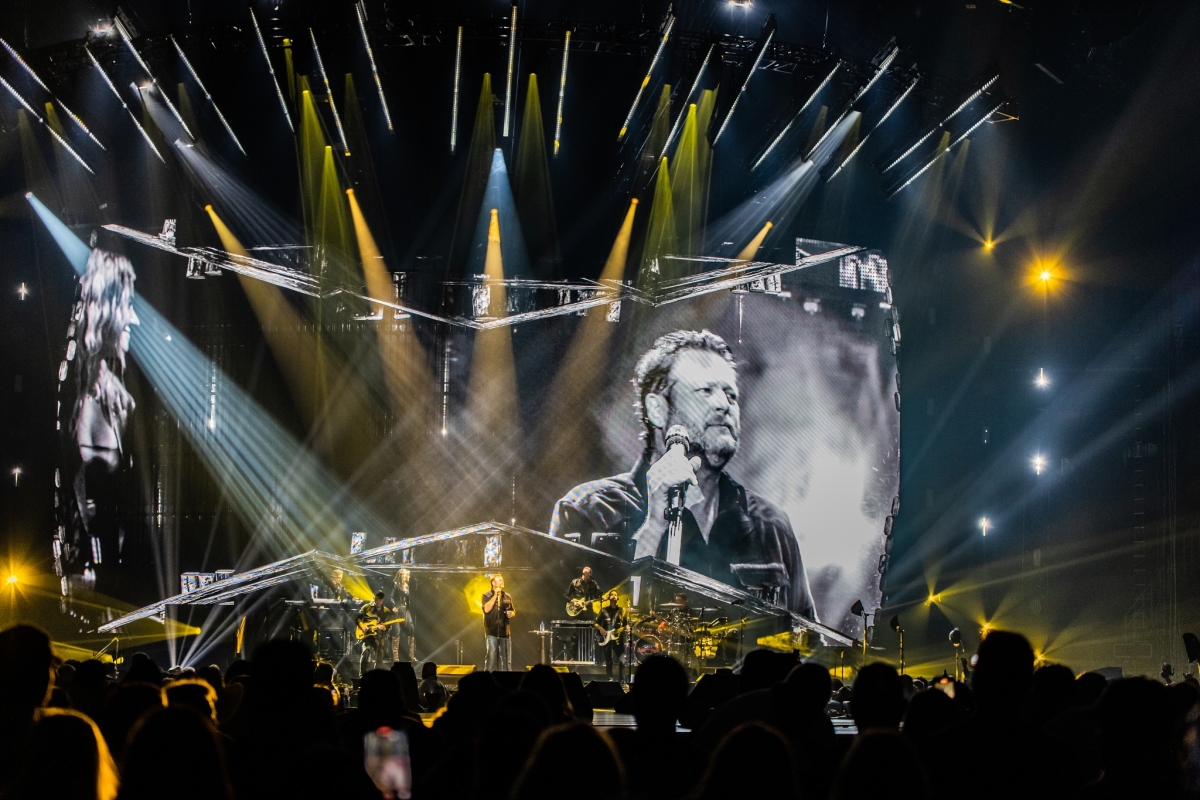
Do you see video eventually being displayed on surfaces other than walls?
“There are already some great examples of that. I think that projection works best when it isn’t on rectangles ! Also there are so many production designers who are marvelous at integrating video as scenic objects. Sooner Routhier springs to mind, as do Tamlyn Wright, Alex Reardon. I see some great examples of that in broadcast. Florian Wieder’s new design for American Idol is off the hook that way.”
Scott Holthaus. Red Hot Chili Peppers
Transparent (Blow-Through Video Walls:
“Funny I tried to pitch transparent layers to RHCPa couple years ago but they said it looked like suspenders and belt.”
Generative Video Spill:
“All of our video with (Red Hot Chili) Peppers is generative, we now employ a VJ to manipulate content in real time.”
IMAG Becomes Part of Design:
“This is a most important point! Peter Mench of Q Prime taught me years ago the importance of IMAG ‘face’ in larger venues. People don’t come to see my art as much as they are there to see the artist they love and their facial gestures and interactions that they can’t see from six hundred feet away. My goal is not to have two separate shows going on… center acting area and TV’s on the flanks but to integrate it into one Tableau while still showing “face” in an interesting way that ties into the center.
“One contrary note to this discussion — I’m doing a design for Disturbed’s summer shed tour with no onstage video at all .. but still using altered side IMAG ‘Faces.” It’s the most exciting thing in recent memory. I have been waiting for an act to be brave enough to not lean on the big upstage TV behind them and do some real theatrical stuff.. so excited.”

Photo: Todd Kaplan
Roles of Video and Light:
“I am certainly guilty of searching for ways to better group fixtures so as to capitalize on pixel mapping. be it 200 Par 64 bulbs for Alice in chains playing bitmap movies over the array or 25 way pods of magic panels that the same center regenerative video screen effects spill over onto the arrays thus making lighting and video one big cohesive being. In this journey, we have found colors from the video mapping that I just haven’t found in lighting color mixing. It might sound nuts but I am using the color brown in lighting for the first time in my life… No.. really.. autumn leaf brown!”
Do you see video eventually being displayed on surfaces other than walls?
“Trying to think of surfaces that are translucent and not affected by wind that can be used in large venues, but Projection, however analog beautiful, is on pause at the moment. I bet someone will wow us really soon with some textural projection.”
Nathan Alves and Seth Jackson – The Darkroom Creative, St. Louis
The Role of AI:
“AI like anything else, is another tool in the toolbelt of a creator. At Darkroom we don’t see AI changing the role of video, we see it as an interesting new avenue we can use to ideate and help us create the experiences we deliver to our clients and their fans.” Nathan
Transparent (Blow-Through) Video Walls:
“One of our guiding principles when designing a stage is a powerful desire to not see where the magic lives. It’s very much the wizard of oz ‘please pay no attention to the man behind the curtain.’ We don’t want our audiences to see the technology if we can help it. Anything that helps me reach that goal is going to be a massive value add for me” Nathan.
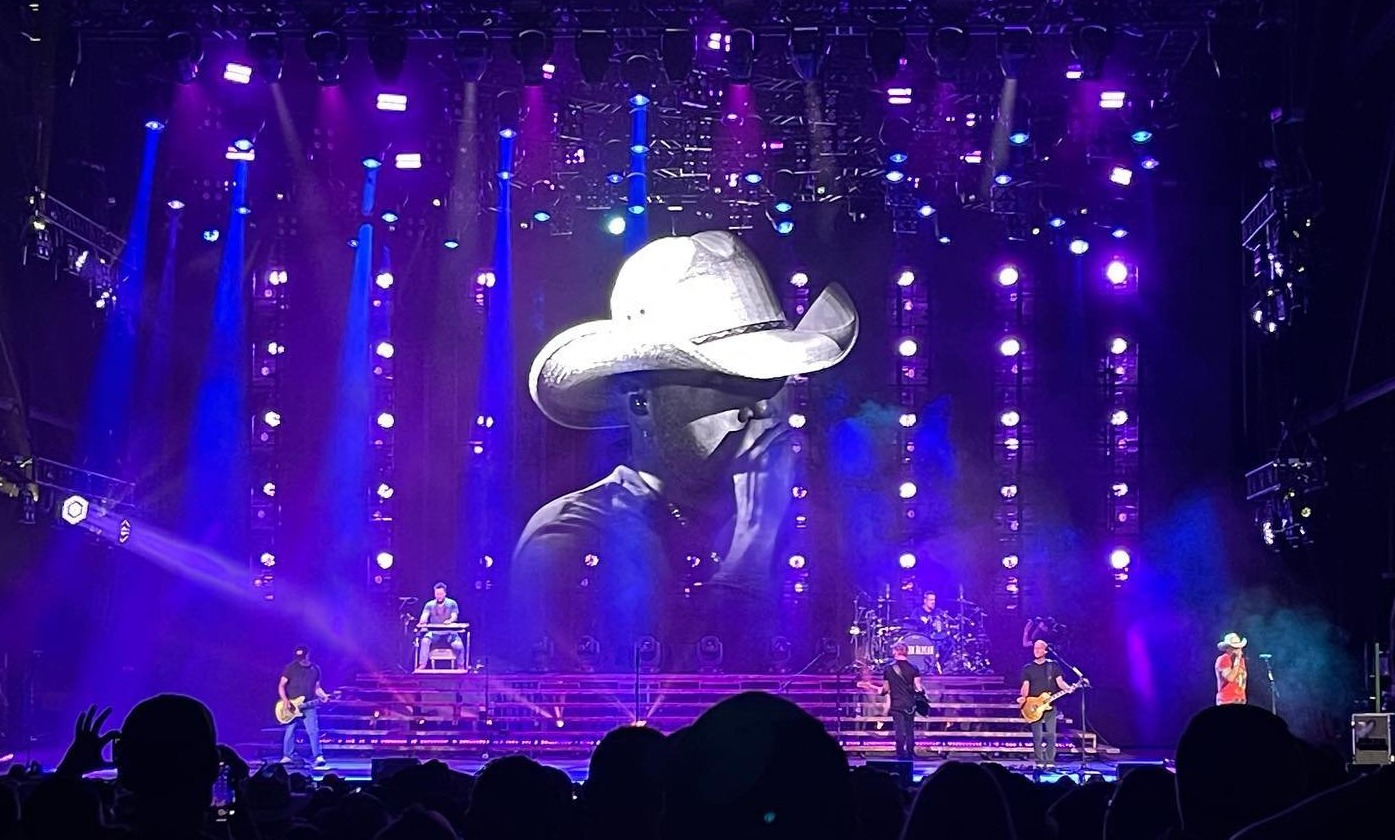
Photo: JP and Sharyn Angers
“Though I do have some trepidation that the blow-through screens could become oversaturated and ‘been there done that.’ I think at this point it is a wonderful tool that can create depth and ‘OZ-like, moments to steal from Nate.” Seth
Generative Video in Design?
“This topic goes two ways. If we are talking about using the LED tile like a light fixture, and using generative video engines to make abstract color and video washes as I call them. Yes, as I’ll get into in a second it is a bigger part of our workflow, but not because of the generative part, we’re just into using all the light sources on a stage holistically these days as opposed to one thing being a light and another being a video element. If we’re talking about generative video in the realm of using notch and game engine technology to speed up (or eliminate) the render pipeline, make virtual environments, and set extensions that help us take the audience somewhere without fabrication. Well, to quote the Mandalorian, this is the way.”
“The video vs. Lighting wars of ten years ago have gone. Often it is the same creative force working together. In our case, we work as a team on a full visual picture. If a screen needs to come down, a light level needs to be enhanced we work with that as a fully developed concept. It is no longer turn down the screen vs. get brighter lights!” Seth
IMAG Video as Part of Design: “We tend to design things these days with a holistic, ‘everything is a part of the look’ mentality. If we’re using screens as part of a design, our goal is to have everything displayed hold the audience in the environment and emotion that this moment creates.” Nathan
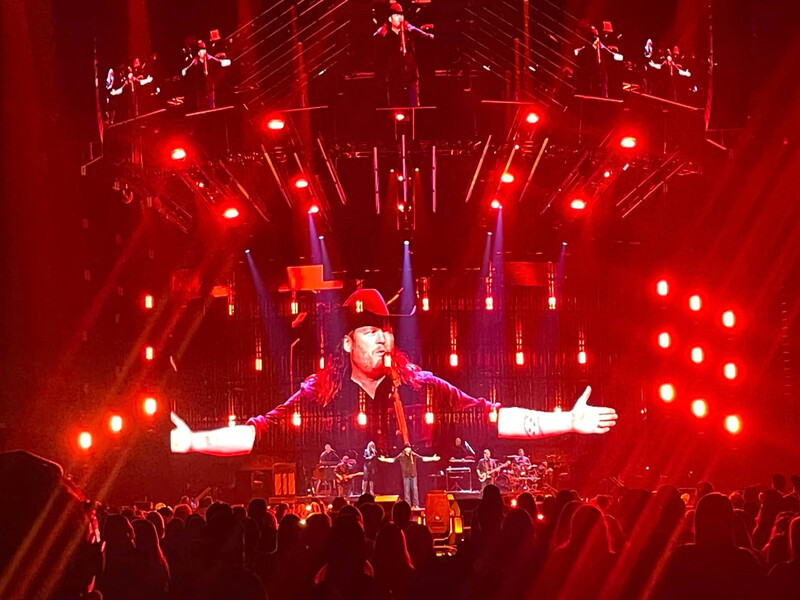
“There is nothing more boring than a floating head on a screen. There is also an audience that is groomed to look at screens in every part of their life and the idea of a show without it is a tough sell these days. S0, You must make it part of the picture, part of the emotion, part of the experience. Otherwise, you end up with the audience staring at a screen when the real thing is right in front of them.” Seth
Video and Lighting:
“I do not see it as one discipline moving the other. It is all lighting, and it is all video. Turn off all your living room lights. Turn on the television as bright as you can make it and set the whole screen in any color you would like. Your TV — a video screen — just became a wash light. Introduce a camera and it’s a screen again? I don’t think it matters much whether we call it one or the other as much as we look at it as a part of design holistically. Screens make light, consoles control individual elements inside a screen, we are all playing for the same team these days.
“The camera is much more forgiving today than it was when I-Mag arrived. Better response to color temperature, accurate color rendering, and the ability to respond at much lower footcandles has made this merger much more pleasant.” Nathan
Do you see video eventually being displayed on surfaces other than walls? “These days I try not to call them walls. I call them anything else. Portals, windows, sets, elements, whatever applies to that design. But not walls, walls define a space, keep you somewhere and have a specific shape. We are at a wonderful place now where we can use modern technology to take the audience anywhere, so shapes other than rectangles, when appropriate, are awesome.” Nathan

Photo: Todd Kaplan
Roland Greil, Munich, Germany
AI In The Future
“So far AI has not played a role in my own workflow and design processes. Nevertheless, I think AI will play a significant role in the future. It can’t fully substitute human creativity, but can assist big time and open new perspectives on things, as well as help to create content more efficiently.”
The Impact of Transparent Walls?
“Transparent screens are a very nice creative element, which could be very helpful, if the design concept asks for such a specific look. This kind of screen helps big time to immerse video and lighting as well as create additional depth in designs.
Opportunities Open With Video Spill
“Video sill will 100-percent become more important. Tools like for instance Notch and Unreal are game changers. Especially looking at tight schedules and similar restraints, those applications help big time to work more efficiently and make better creative use of the given time. Beside of that it opens many new possibilities in treating video content and live footage a like.
IMAG’s Role Changing For Good Reason
“The role of IMAGE is changing and absolutely for a good and important reason. Ultimately the difference between a good and a great show is, if the creative team has looked at the bigger picture of a production, which involves all visual elements including video, which therefore includes live IMAG. It is important to treat live IMAG and use it as another scenic visual element makes sure, that IMAG perfectly blends into an over all visual design/ look instead of feeling like an added TV screen.
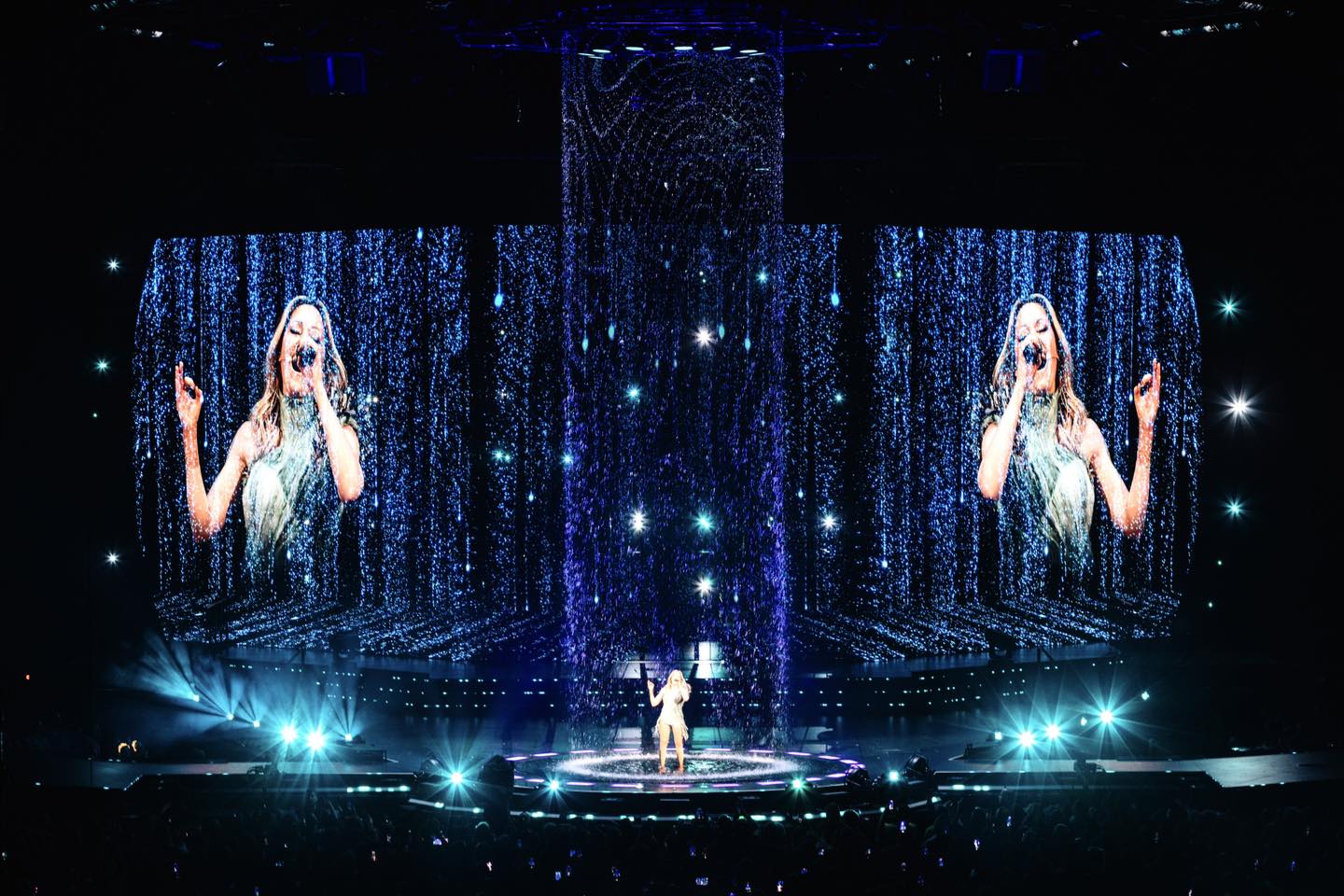
Photo: Sandra Ludewig
The Video- Lighting Relationship
“All developments over the last years/ decades, like media servers, different LED elements, projection mapping and so on have finally brought both worlds closer together. If you think about it, they always belonged together, as they’re both elements of the bigger picture. For obvious reasons therefore they affect each other, but in an all the way through positive form.”
Do you see video eventually being displayed on surfaces other than walls?
“ If you ask my creative free thinking visionary brain half, we could use any surface as a high brightness high-res video element. Just imagine to paint a scenic piece and it magically transforms into exactly that!”
Marc Brickman Tactical Manoeuvre, Los Angeles
On The Role Of AI
“AI is ushering in a new era of design, radically altering the traditional methods of content creation. as both a fine artist and a creator of productions, my perspective has been indelibly impacted by these developments. The ontological implications of AI and technology in design cannot be overstated. with the vast repertoire of digital tools and software at our disposal, we are endowed with unimaginable resources to shape and express our creative vision. the algorithmic prowess of AI can facilitate the generation of complex patterns and designs – raw materials, with which the human artist can then paint.
“The expedient production methods potentially enabled by technology will create a paradigm shift in the industry. while the ubiquitous automation of tasks has engendered fears that the design process may be drained of human creativity and intuition, the enduring relevance of the artist and designer in conceiving and executing creative content cannot be overstated. It is up to us to grow with the technology, to explore and exploit the dynamic interplay between technology and creativity, in order to produce increasingly innovative, relevant and impactful works of art.”
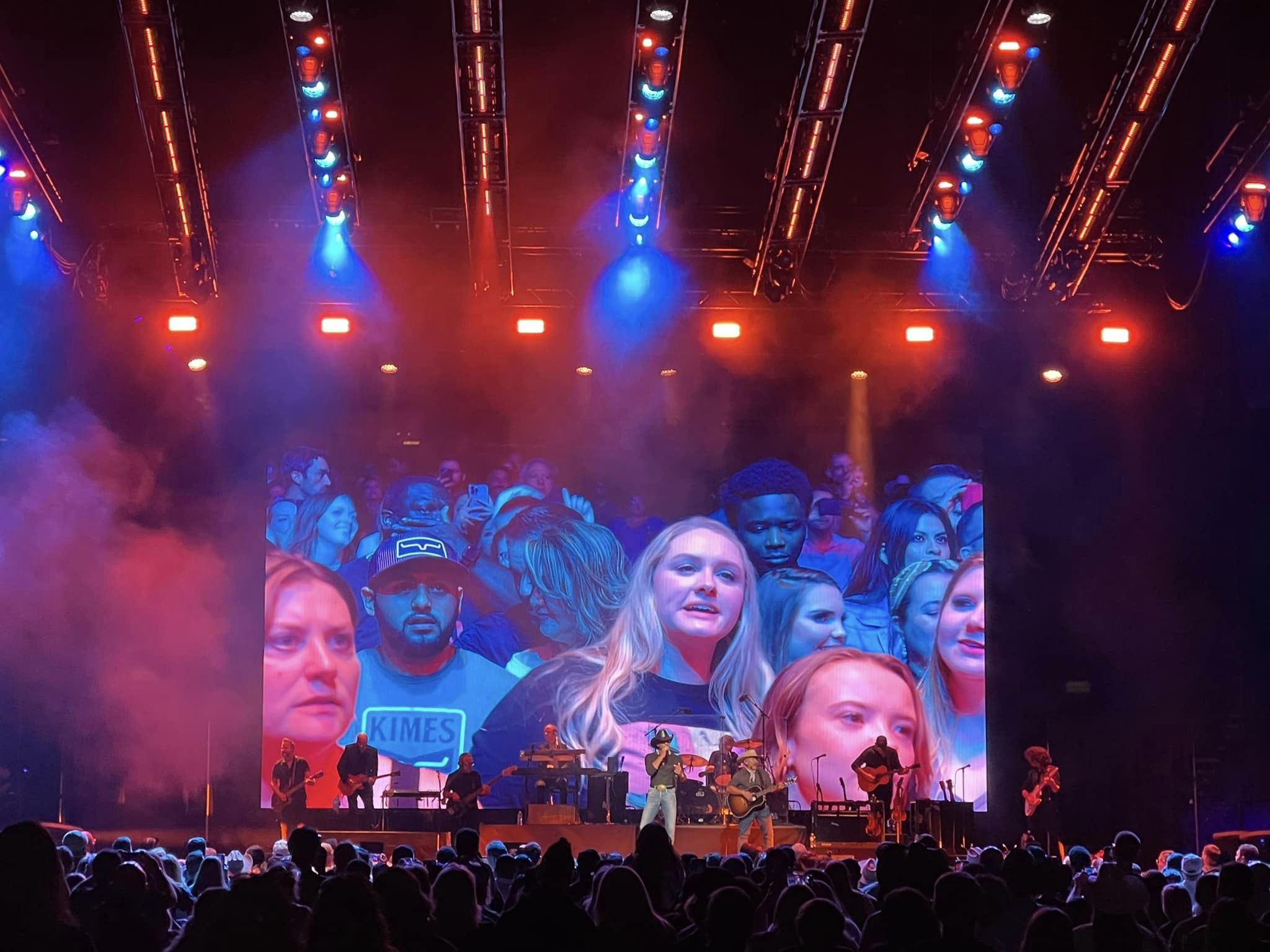
Creative Opportunities Of Transparent Video Walls ?
“The aesthetic possibilities of transparent video walls are myriad, offering the opportunity to create experiential environments that defy the conventional boundaries of physical space. The transparency affords designers a unique opportunity to experiment with layering and depth, blurring the lines between the physical and the virtual – overlaying digital assets onto real-world objects, manipulating and augmenting the physical environment to create an entirely new aesthetic experience. these tools expand the capacity of artists to explore an unprecedented level of visual dynamism, experimenting with the interplay between physical space and digital content.”
Mesmerizing Generative Video Spill
“Generative video spill is creating a lot of excitement, but it’s something I’ve used in my practice for a while. The transformative potential of generative video spill lies in its ability to manipulate complex video content via traditional sources –lights etc. — in real-time, creating mesmerizing and constantly evolving visual landscapes with an infinite variety of forms, materials, and textures.
IMAG In Design
“IMAG has traditionally been employed as vehicle for showcasing stage performances. sadly, the notion that it has now evolved into a significant design element is, unfortunately, not the case in most productions. I would go so far as to argue that the incorporation of IMAG into design is generally an afterthought, a superfluous addendum to the broader design concept. While there may be a handful of designers who are genuinely exploring the creative potential of IMAG video, the vast majority of continue to use it as a functional tool, rather than a design element in its own right.”
Video and Lighting
“In my practice video has had the most unique impact in architectural design, a field where it is seldom employed. In general, architectural lighting is chiefly employed as a functional tool, illuminating buildings for practical purposes. With the advent of new video technologies, we now have the ability to use lighting as a dynamic and interactive design element, transforming buildings into canvases for artistic expression and experimentation. The Empire State Building is an example of the power of both video-driven and generative content feeds that transform a static structure into a dynamic and immersive work of art.”

Photo: Todd Kaplan
Do you see video eventually being displayed on surfaces other than walls?
“The constraints of traditional display formats limit the creative potential of video art. new display methods are vital to the full exploration of the possibilities of the medium. In the fine art and experiential content world, there have been countless explorations of alternative display methods, utilizing a vast array of surfaces and textures. these works challenge our assumptions about what video art can be and offer new avenues for creative exploration and expression. It remains to be seen whether these alternative display methods will become more widely adopted in the world of live production, or whether the traditional flat screen, video wall paradigms will prevail.”
Crt Birsa, Blackout Design Ljubljana, Slovenia
A Card of Surprises
“Transparent video walls add another hidden layer to the set. It is a card of surprise for the designer. With this, a show can be pushed to another level. Also these transparent video walls can be used in multi layer LED walls, which adds a whole new dimension to the stage. I have done some shows with the transparent projection mashes and as well video walls. There are endless possibilities what can you hide back there if you just have enough depth available in the venue.”
Generative Video Spill Warning
“I think video spill is good for some effects during the show, but I would not use it too much. You lose the layers of lighting and video. Lights and video are glued together and the depth is gone. It is a cool effect when you have a lot of multipixel lights that at least vaguely replicate what the video is doing, but I would still take it as an effect rather than the way to do the show.”

More IMAG
“The older I get, the more I understand the importance of IMAG. The audience who bought the tickets want to see the artist. Not everybody can be close to the stage and IMAG is the solution. But if you are looking at the artist for 1,5 h I think there is no harm for now and then to spice up the stream with some effects or other visual content that supports the show.”
Beyond Walls
“With the video projection we have done many interesting things already. Also LED surfaces are changing a lot so yes we will see video on surfaces other than walls. I can’t wait of the moment where we wont limited to 0,5 x 1 m or similar segments anymore.”
How do recent developments in video affect the use lighting?
“There is more and more use of video, so it is important that the video designers and lighting designers work closely together on their shows. Everybody affects everybody. But with a good collaboration the show can be much stronger. Video is a very powerful tool so it is very important what content to show because with the video you can completely guide the understanding of the show from the audience point of view”.